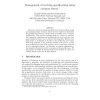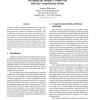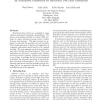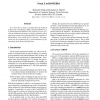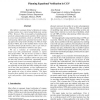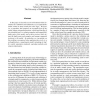97
Voted
KBSE
1998
IEEE
15 years 4 months ago
1998
IEEE
Starting from a graphical data model (a subset of the OMT object model), a skeleton of formal specification can be generated and completed to express several constraints and provi...
87
Voted
KBSE
1998
IEEE
15 years 5 months ago
1998
IEEE
111
click to vote
KBSE
1998
IEEE
15 years 5 months ago
1998
IEEE
Cognitive models of software comprehension are potential sources of theoretical knowledge for tool designers. Although their use in analysis of existing tools is fairly wellestabl...
101
click to vote
KBSE
1998
IEEE
15 years 5 months ago
1998
IEEE
Structural testing criteria are mandated in many software development standards and guidelines. The process of generating test-data to achieve 100 coverage of a given structural c...
93
Voted
KBSE
1998
IEEE
15 years 5 months ago
1998
IEEE
Automated user-interface generation environments have been criticized for their failure to deliver rich and powerful interactive applications [18]. To specify more powerful system...
114
Voted
KBSE
1998
IEEE
15 years 5 months ago
1998
IEEE
It is shown how to make a transition from the Z formal notation [3] to the Business Object Notation (BON) [4]. It is demonstrated that BON has the expressive power of Z, with the ...
101
click to vote
KBSE
1998
IEEE
15 years 5 months ago
1998
IEEE
Most efforts to automate formal verification of communicating systems have centred around finite-state systems (FSSs). However, FSSs are incapable of modelling many practical comm...
121
Voted
KBSE
1998
IEEE
15 years 5 months ago
1998
IEEE
We report on GADGET, a new software test generation system that uses combinatorial optimization to obtain condition/decision coverage of C/C++ programs. The GADGET system is fully...
100
Voted
KBSE
1998
IEEE
15 years 5 months ago
1998
IEEE
In this paper we describe a tools environment which automates the validation and maintenance of a requirements model written in many-sorted first order logic. We focus on: a trans...
119
Voted
KBSE
1998
IEEE
15 years 5 months ago
1998
IEEE
During the last three years we have been building an instantiation of a system's development paradigm, called ARTS. The paradigm consists of a view of what a system developme...

